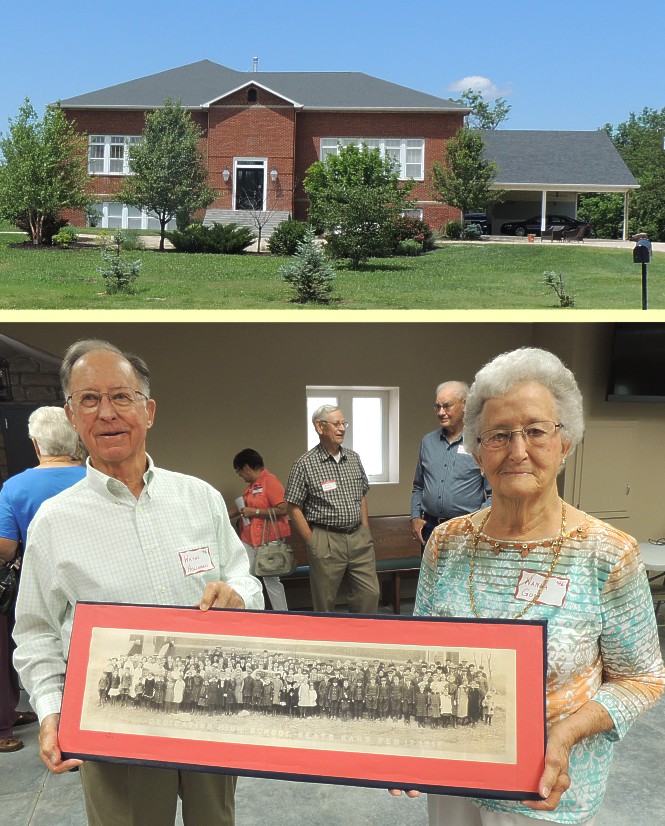Kansas Snapshots by Gloria Freeland - June 10, 2016
A lively time
A crowd of about 65 had gathered by the time I arrived on May 29 at the new Keats Center. Everyone was smiling and greeting
friends. People had gathered to celebrate the centennial of the Keats Rural High School - KRHS.
I've only lived in the community since 1988, but I thought it would be fun to chat with some of those who attended KRHS,
other neighbors and perhaps make a new acquaintance or two. I had attended a small school in a small town and so felt I would
probably enjoy myself.
Despite it being only several hundred feet east of our home, my only previous experience with the school was in the 1990s
when I bought a Klemp kitchen hutch there when part of the school was being used as an antique store. Then the building was
largely vacant until a few years ago when a family renovated it into a home and a business.
Warren Blodgett grew up just a mile west of the schoolhouse and he remembers walking to school until there were buses. He
played baseball and was on the basketball team, which played other local teams in Riley, Leonardville and other nearby small
towns.
Today, Warren, a 1956 graduate, and his wife Kay, live just east of the schoolhouse. He said the new owners sanded and
refinished the maple floors and retained some elements, such as a water fountain and some blackboards.
They both recall when Keats had a post office, a grocery store, two filling stations, an elevator and a stockyard near the
Rock Island railroad tracks. For a time, Kay had a beauty shop.
The high school opened in fall 1916 and was dedicated on Feb. 17, 1917. It was the first rural high school in Riley County.
But in the fall of 1958, high school students were taken to Riley and the building was used by the grade school. Both schools
eventually closed and students bused to Riley and Leonardville.
But in those 42 years, 517 students enrolled and 351 graduated. Lily Schwab was the first graduate and her nephew Charles
Schurle was the last to receive his diploma.
Wayne Hollowell, a 1946 graduate, said the first alumni reunion was in 1959. Reunions were held every four years until
1980, and every two years on Memorial Day weekend since. This centennial year, alumni of both closed schools, family members
and friends were present.
Wayne said during his time at KRHS, most of the teachers were wives of military men from nearby Fort Riley.
"I have often commented on the commitment on the part of the lady teachers," he said. "They each took us under their wing
and handled us individually to make us successful."
He said there were 14 students in his graduating class, including his twin sister Wanda Goff.
"My favorite subject was geography," he said. "I had never been outside of Kansas so each study of a foreign country was a
new adventure. Of course, there was no TV and only a few years of radio, so we had extremely limited knowledge outside of
Riley County and the State of Kansas."
J. Lester Hooper, an educator for 38 years who taught science and industrial arts at KRHS during the 1956-'57 and 1957-'58
school years, also attended the reunion. During his last year, he was also the senior class sponsor, was in charge of the play
and the yearbook, and drove a school bus.
"It was a really good experience because the parents and community backed the school and the church and made the kids
mind," he said.
Myrna Hilton Kennedy, a 1951 graduate and educator, said she always looks forward to the KRHS reunions.
"Keats has always been a community centered around the school and church activities," she said. "Even though we had very
few students in the last years, I feel like we were given a good education."
Her Aunt Ethel Hilton graduated from Keats in 1918, her father Aubrey Hilton in 1921, her sister Idamae Hilton in 1946, and
her brother Robert (Bobby Jack) in 1953.
"... so my love of Keats goes back through many generations," she said. "Even though I do not live there anymore, I always
look forward to going back every two years for the reunion."
Her favorite subjects were music, home economics and sports.
"We had basketball teams (both boys and girls), softball team, plays, and music groups," she said. "Singing was my passion,
and we attended many music festivals and usually came home with high ratings. I participated in solos, duets, and a quartet.
We had a mixed quartet which was very active. I also played the piano and accompanied many groups and solos."
After moving into town from a nearby farm, she became even more involved in the community.
"We walked to and from school and knew everyone that lived in the town. My best friend (Betty Hollowell) and I used to
walk around town almost every evening talking to the people and singing duets. We were also very active in our church and so
spent a lot of time at the church as well as the school."
Wayne said, "Virtually all students participated in all sports, school plays, etc.. Because of the limited enrollment,
everyone was needed to make the effort successful. That is why the Wildcat 4-H Club served the dinner and cleaned up after it
because they are the singular youth activity for the immediate area. And the Keats Lions Club regularly holds meals at the
new Community Center and Keats Park. All the activities work to keep Keats alive."
Alive, indeed! On May 29, I was looking forward to an interesting visit. But Keats wasn't just alive, it was lively!
